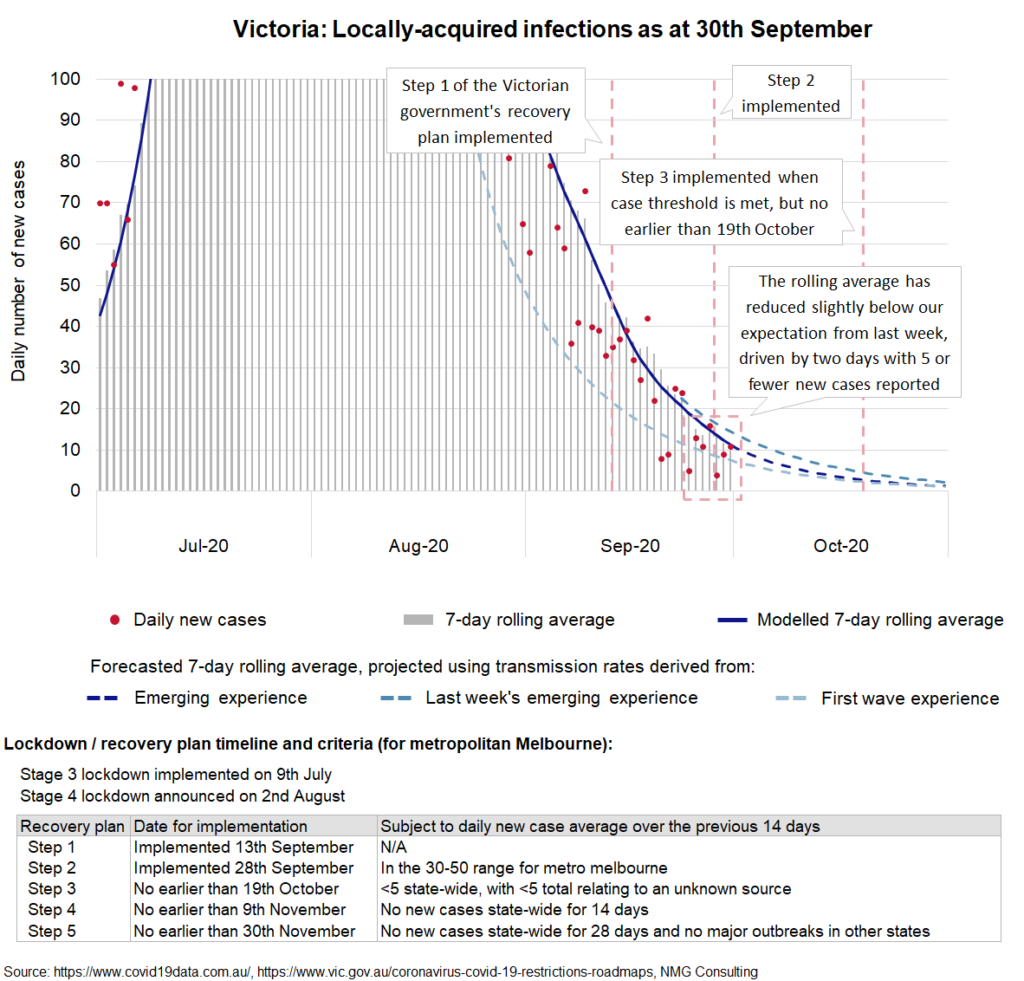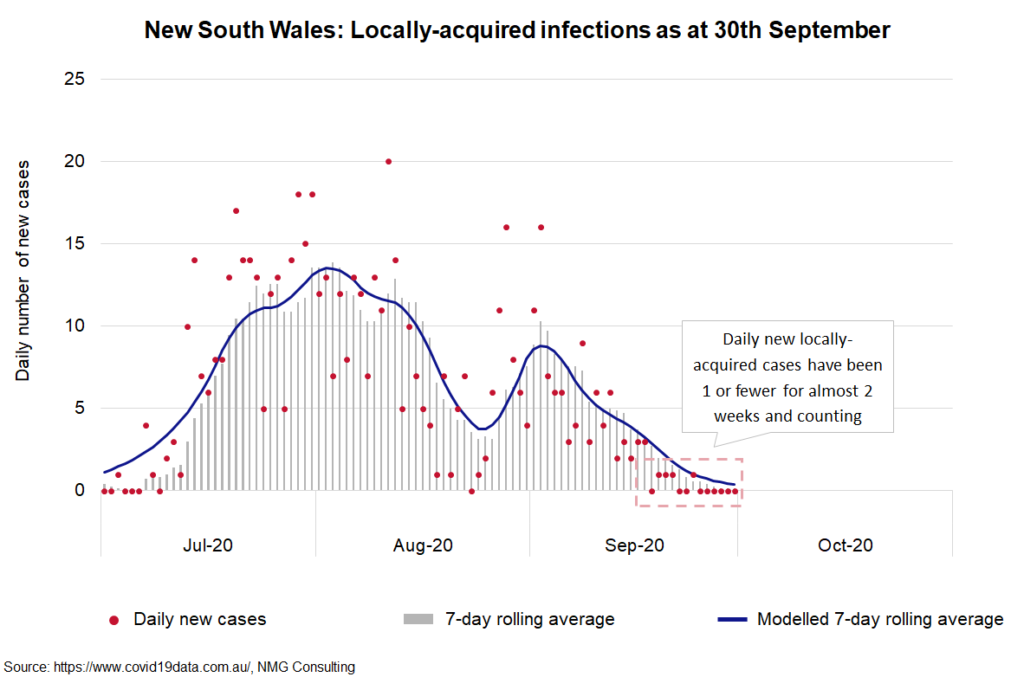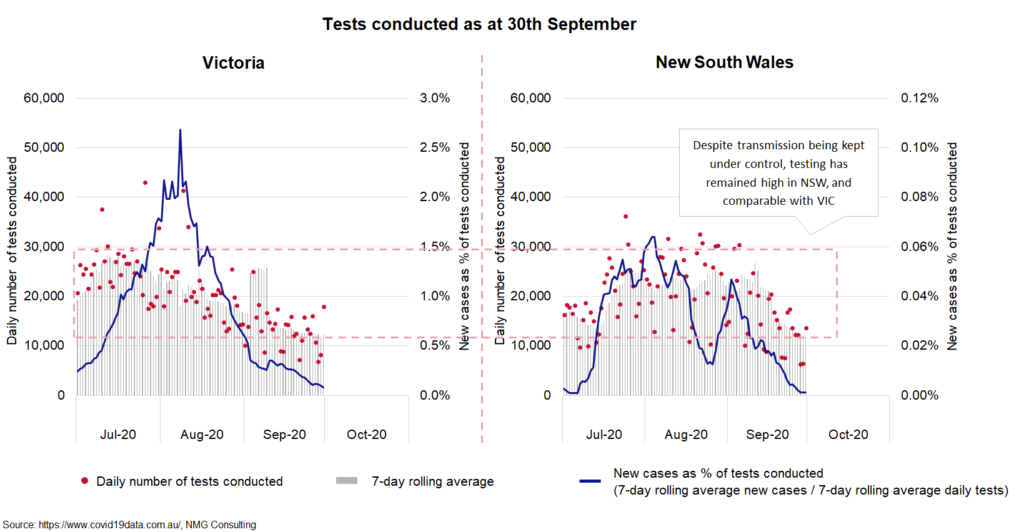May 4, 2020
ESG endures the crisis: Environmental and social factor adoption set to accelerate
Environmental, Social and Governance (ESG) investing has been the leading topic of interest amongst asset owners globally….
Our goal is to share regular updates to modelled scenarios for the potential development of Covid-19 in Australia (specifically, Victoria and New South Wales).
Background
Our data analytics teams operate a multi-state model to generate scenarios for the potential development of the Covid-19 pandemic across several countries in Asia Pacific, as well as South Africa.
Having modelled the first-wave developments in Australia, Matthew Tiong has continued to apply and adapt these models to the second wave of infections spreading in Victoria and New South Wales. While Matt has had the benefit of feedback from the Covid-19 working group of the Institute of Actuaries of Australia, the model outputs and opinions expressed here are his own.
Victoria: Modelled scenarios
7-day average declining faster than expected, metro Melbourne transitioned to step 2 on 28th September as expected, likely to achieve step 3 threshold on 19th October, but should take progressive measures before then
Metropolitan Melbourne and regional Victoria are currently in steps 2 and 3 of the Andrews’ government’s 5-step plan respectively. Given the progression to subsequent steps of the plan for both regions requires a daily new case threshold to be met, our modelling provides an indication of the likely achievability of these targets.

Comparing the dark blue line with the grey bars and the medium blue line shows that the state-wide transmission rate has reduced again this week, and that the 7-day rolling average for newly-reported cases has reduced below what we expected last week (ie the 7-day average fell from 22 last week to 10 this week, versus our expectation of 15 from last week).
Metropolitan Melbourne
On Sunday night, Daniel Andrews confirmed that metro Melbourne had met the 14-day average new case threshold for step 2 and would make the transition on 28th September as planned. He also announced a raft of changes to the existing recovery roadmap representing the further easing of restrictions under step 2. The changes include:
In addition to these changes, Daniel Andrews also announced that the progression to steps 3 to 5 now require only three weeks between each step, subject to the new case thresholds being met. This means that for metro Melbourne, step 3 may be entered as early as 19th October (compared to 26th October previously), step 4 as early as 9th November (versus 23rd November), and step 5 as early as 30th November (no date previously set).
See a transcript of the premier’s press conference here.
What does our model say about the potential transition to step 3? With the latest transmission rate experience reflected in our expectation for the forward-looking transmission rate, our model is projecting a 14-day average of 3-4 cases per day on 19th October, which is below the required threshold for step 3. It appears likely that Victoria will meet the required threshold and metro Melbourne will make the transition after three weeks, albeit that with a target of only 5 cases per day, it will take only a handful of cases to throw the 14-day average off course.
Regional Victoria
Regional Victoria transitioned to step 3 on 16th September.
Given that the progression to step 4 requires no new cases for 14 days state-wide (and no earlier than 7th October under the updated plan), those living in regional Victoria should expect the step 3 restrictions to last for a little while yet. As we asserted in previous weeks, if the recent experience in NSW is indicative, having no new cases reported state-wide over a 14-day period will be a difficult threshold to achieve, even with effective suppression and contact tracing.
What is the right plan for re-opening?
Has the Victorian government gone far enough with their adjustments to the recovery roadmap, and is keeping metro Melbourne effectively locked down the correct strategy?
It is fair to suggest that the Victorian teams tasked with contact tracing can reasonably be expected to cope with case numbers prevailing at the levels seen over the past week. As a case in point, one needs only look at the experience in NSW where the 7-day average was at around the same level (~10 new cases per day) in early September but has reduced to almost 0 by the end of September, all without the same stringent lockdowns that Victoria currently has in place.
While keeping metro Melbourne in lockdown is almost definitely going to be the more effective strategy for reducing new cases, it is worth questioning whether the faster reduction in cases is worth the sacrifice. The experience in NSW clearly indicates otherwise. At the very least, high school students (not just primary schools students) should be allowed to return to school.
New South Wales: Emerging experience
Only one new locally-acquired case reported over the past week, testing statistics support view that transmission is under control, Singapore opens its borders to NSW before QLD!
This week, NSW saw the number of cases continue to trend downwards, with only one new locally-acquired case reported over the past week (compared to six the week prior). It appears that transmission is well and truly under control (for now).

When will the NSW/QLD border reopen? Our view remains that with Queensland tracking at current levels (no new locally-acquired cases reported over the past week) and yet another week of experience suggesting NSW has kept transmission under control, a broader opening of the border is most-definitely warranted. Even Singapore has decided to allow entry to Australian travellers (excluding Victoria), beginning next week.
Testing statistics
Declining positive testing rate implies transmission under control, continued high testing rates in NSW part of the secret to success

While the number of tests conducted has indeed been reducing in both states, it is worth noting that the proportion of tests returning a positive result (measured as the 7-day average for newly reported cases divided by the 7-day average for number of tests conducted) has also been reducing, and hence we might expect that even if more tests were to be conducted, a significant increase in new cases is unlikely.
Another interesting observation is that despite the relative success in controlling transmission in NSW, testing has remained high (and comparable to the levels seen in Victoria), and is likely to be one of the key contributing factors to the success observed in NSW.